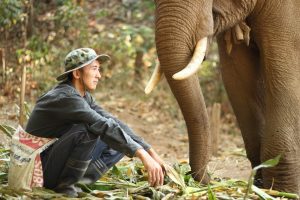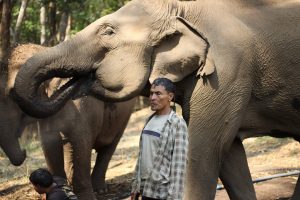Explore the different types of peccaries found in Costa Rica, as well as their importance in the local ecosystem, habitats, behavior, and social structure.
GVI
Posted: May 10, 2023

Posted: August 22, 2020
Thailand did a pretty good job of controlling and then eradicating COVID-19. For months now there have been no new cases, except from foreigners who have entered the country, and who are then strictly quarantined to prevent the spread.
This has undoubtedly saved many lives, however Thailand is a country that relies heavily on tourism, and so with international borders closed, businesses that usually rely on international tourists are having to find new ways to bring in money.
The elephant tourism industry has been particularly hard-hit. The majority of Thailand’s captive elephants work in tourism camps, and with no money coming in, the camps have not been able to pay for the upkeep of these elephants. Because of this, there has been a mass-migration of around 1000 elephants from tourism camps in the city, back to the small villages where they came from and where their owners live.
This is what happened in the village of Huay Pakoot, where GVI’s project is based. The villagers there rely on the income from elephants, with most village families owning at least one elephant. The special bond that families have with their elephants means that when tourism camps closed, they walked back from Chiang Mai to the village together, over 3 days, so their elephants could be at home in the forest with them and could be looked after. Huay Pakoot went from having a population of just 12 elephants (from GVI’s project and another similar project), to over 50.

Unfortunately, when COVID-19 first hit, it was the dry season in Northern Thailand, so there was not enough natural food in the forest to feed all these elephants; and space was limited too. All the villagers helped each other out by each driving 3 hours a day to buy elephant grass from the nearest town, and bringing it back. The dry season is also extremely hot, so villagers were also ferrying water back and forth for the elephants.
Those first few months really show the dedication of the villagers to their elephants. Without their usual income, they were still spending all their money, time and resources into caring for these animals and ensuring they were well-fed and comfortable. As the pandemic continues to restrict tourism, the villagers in Huay Pakoot are meeting with authorities to find longer-term solutions for their elephants, including growing more elephant grass in the village, and promoting domestic tourism. As for us at GVI, we can’t wait to get back there and resume our project with Huay Pakoot, when it is safe to do so again!
If you are interested to donate to help out the villagers and elephants, you can do so here: https://www.globalgiving.org/projects/elephant-rescue-thailand/

Explore the different types of peccaries found in Costa Rica, as well as their importance in the local ecosystem, habitats, behavior, and social structure.
GVI
Posted: May 10, 2023